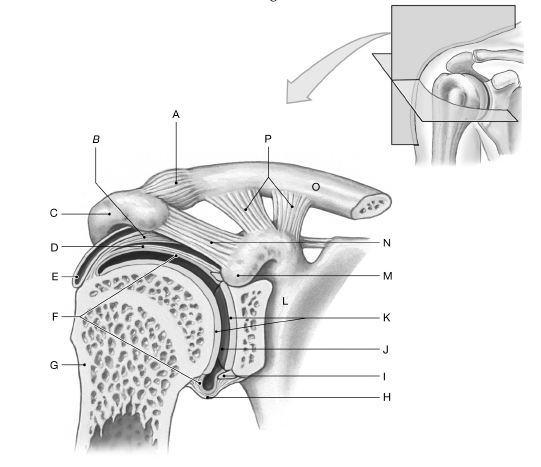Using the figure below, identify the labeled part.

1) Label A: ______________________________
2) Label B: ______________________________
3) Label C: ______________________________
4) Label D: ______________________________
5) Label E: ______________________________
6) Label F: ______________________________
7) Label G: ______________________________
8) Label H: ______________________________
9) Label I: ______________________________
10) Label J: ______________________________
11) Label K: ______________________________
12) Label L: ______________________________
13) Label M: ______________________________
14) Label N: ______________________________
15) Label O: ______________________________
16) Label P: ______________________________
1) Acromioclavicular ligaments
2) Tendon of supraspinatus muscle
3) Acromion
4) Articular capsule
5) Subdeltoid bursa
6) Synovial membrane
7) Humerus
8) Articular capsule
9) Glenoid labrum
10) Joint cavity
11) Articular cartilages
12) Scapula
13) Coracoid process
14) Coracoacromial ligament
15) Clavicle
16) Coracoclavicular ligaments
You might also like to view...
Johnny fractured the lower third of his right tibia in a skiing accident. The soft tissues in the area were severely damaged and their surgical removal was necessary. After prolonged immobilization, it was found that Johnny was healing very poorly
The explanation offered by the orthopedic surgeon was that vascularization of the fracture site was still inadequate and good healing was absolutely dependent upon an adequate blood supply. Describe how a long bone receives its blood supply and trace the path of nutrient delivery to the osteocytes. What will be an ideal response
What neurotransmitter is released by the axon of a sympathetic preganglionic neuron to communicate with the sympathetic postganglionic neuron?
A) norepinephrine B) adrenalin C) epinephrine D) acetylcholine
For better retention of material, it is better to break up study sessions into multiple smaller chunks (e.g. 30 minutes each) rather than fewer, longer sessions (e.g. several hours each).
Answer the following statement true (T) or false (F)
The two major types of phagocytic cells are
A. neutrophils and monocytes. B. neutrophils and macrophages. C. monocytes and macrophages. D. lymphocytes and monocytes. E. eosinophils and T cells.